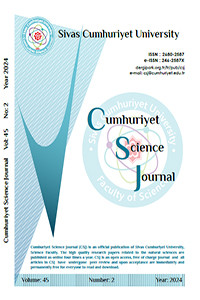Abstract
References
- [1] Pisarenko V. F., Sornette A., Sornette D., Rodkin, M. V., Characterization of the tail of the distribution of earthquake magnitudes by combining the GEV and GPD descriptions of extreme value theory, Pure and Applied Geophysics, 171 (2014) 1599-1624.
- [2] Ma N., Bai Y., Meng S., Return period evaluation of the largest possible earthquake magnitudes in mainland China based on extreme value theory, Sensors, 21(10) (2021) 3519.
- [3] Beyreuther M., Wassermann J., Continuous earthquake detection and classification using discrete Hidden Markov Models, Geophysical Journal International, 175(3) (2008) 1055-1066.
- [4] Yip C. F., Ng W. L., Yau, C. Y., A hidden Markov model for earthquake prediction, Stochastic Environmental Research and Risk Assessment, 32 (2018) 1415-1434.
- [5] Li Z., Meier M. A., Hauksson E., Zhan Z., Andrews J., Machine learning seismic wave discrimination: Application to earthquake early warning, Geophysical Research Letters, 45(10) (2018) 4773-4779.
- [6] Mangalathu S., Sun H., Nweke C. C., Yi Z., Burton H. V., Classifying earthquake damage to buildings using machine learning, Earthquake Spectra, 36(1) (2020) 183-208.
- [7] Tehseen R., Farooq M. S., Abid, A., Earthquake prediction using expert systems: a systematic mapping study, Sustainability, 12(6) (2020) 2420.
- [8] Li W., Chakraborty M., Köhler J., Quinteros-Cartaya C., Rümpker G., Srivastava N., Earthquake monitoring using deep learning with a case study of the Kahramanmaras Turkey earthquake aftershock sequence, Solid Earth, 15(2) (2024) 197-213.
- [9] Hussain E., Kalaycıoğlu S., Milline, C. W., Çakir Z., Preconditioning the 2023 Kahramanmaraş (Türkiye) earthquake disaster, Nature Reviews Earth & Environment, (2023) 1-3.
- [10] Kocaman İ., The effect of the Kahramanmaraş earthquakes (Mw 7.7 and Mw 7.6) on historical masonry mosques and minarets, Engineering Failure Analysis, 149 (2023) 107225.
- [11] Lawal B., Lawal H. B., Categorical data analysis with SAS and SPSS applications, Psychology Press, (2003).
- [12] Agresti A., Categorical data analysis (Vol. 482). John Wiley & Sons, (2003)
Abstract
Researchers have conducted numerous studies on earthquakes and aftershocks, some of which have utilized statistical analysis methods. However, there is no direct research examining the interaction between variables thought to influence aftershocks following major earthquakes. In this study, 2194 aftershocks with a magnitude of 3 or higher that occurred after two major earthquakes in Turkey on February 6, 2023 were analyzed using log-linear models with respect to variables such as depth, magnitude, time, and city. At the end of the study, all four primary variables - city, magnitude, depth, and time - were found to be statistically significant. Based on the parameter estimation values, it was found that the probability of aftershocks occurring in Malatya was 1.17 times greater than in Adıyaman, 2.82 times greater than in Gaziantep, and 1.38 times greater than in Hatay, while the probability of aftershocks occurring in Kahramanmaraş was 3 times greater than in Malatya. Thus, it can be said that the aftershocks are influenced by the center of the major earthquake. Additionally, it was found that the probability of aftershocks with a magnitude between 3 and 3.5 was 1.4 times greater than those with a magnitude of 4 or higher, and the probability of aftershocks with a depth of less than 10 kilometers was 2 times greater. We believe that the results of this study will provide information on aftershocks that occur after major earthquakes and will be helpful for future studies.
References
- [1] Pisarenko V. F., Sornette A., Sornette D., Rodkin, M. V., Characterization of the tail of the distribution of earthquake magnitudes by combining the GEV and GPD descriptions of extreme value theory, Pure and Applied Geophysics, 171 (2014) 1599-1624.
- [2] Ma N., Bai Y., Meng S., Return period evaluation of the largest possible earthquake magnitudes in mainland China based on extreme value theory, Sensors, 21(10) (2021) 3519.
- [3] Beyreuther M., Wassermann J., Continuous earthquake detection and classification using discrete Hidden Markov Models, Geophysical Journal International, 175(3) (2008) 1055-1066.
- [4] Yip C. F., Ng W. L., Yau, C. Y., A hidden Markov model for earthquake prediction, Stochastic Environmental Research and Risk Assessment, 32 (2018) 1415-1434.
- [5] Li Z., Meier M. A., Hauksson E., Zhan Z., Andrews J., Machine learning seismic wave discrimination: Application to earthquake early warning, Geophysical Research Letters, 45(10) (2018) 4773-4779.
- [6] Mangalathu S., Sun H., Nweke C. C., Yi Z., Burton H. V., Classifying earthquake damage to buildings using machine learning, Earthquake Spectra, 36(1) (2020) 183-208.
- [7] Tehseen R., Farooq M. S., Abid, A., Earthquake prediction using expert systems: a systematic mapping study, Sustainability, 12(6) (2020) 2420.
- [8] Li W., Chakraborty M., Köhler J., Quinteros-Cartaya C., Rümpker G., Srivastava N., Earthquake monitoring using deep learning with a case study of the Kahramanmaras Turkey earthquake aftershock sequence, Solid Earth, 15(2) (2024) 197-213.
- [9] Hussain E., Kalaycıoğlu S., Milline, C. W., Çakir Z., Preconditioning the 2023 Kahramanmaraş (Türkiye) earthquake disaster, Nature Reviews Earth & Environment, (2023) 1-3.
- [10] Kocaman İ., The effect of the Kahramanmaraş earthquakes (Mw 7.7 and Mw 7.6) on historical masonry mosques and minarets, Engineering Failure Analysis, 149 (2023) 107225.
- [11] Lawal B., Lawal H. B., Categorical data analysis with SAS and SPSS applications, Psychology Press, (2003).
- [12] Agresti A., Categorical data analysis (Vol. 482). John Wiley & Sons, (2003)
Details
| Primary Language | English |
|---|---|
| Subjects | Statistical Analysis |
| Journal Section | Research Article |
| Authors | |
| Publication Date | June 30, 2024 |
| Submission Date | November 8, 2023 |
| Acceptance Date | March 15, 2024 |
| Published in Issue | Year 2024 Volume: 45 Issue: 2 |

